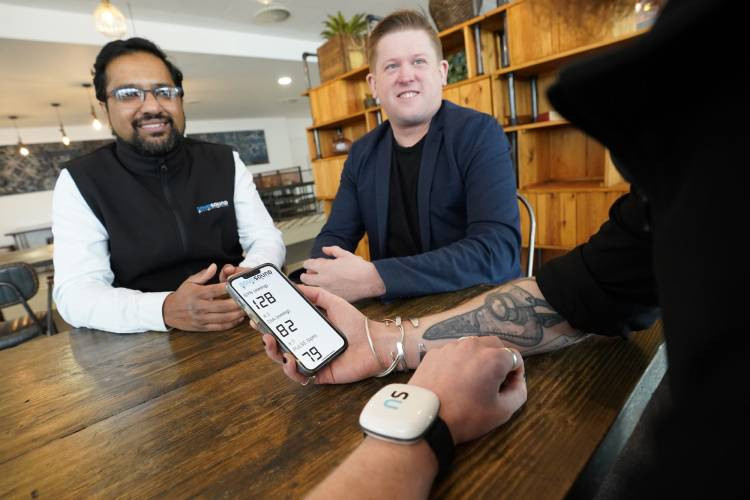Ultrasound Blood Pressure Wearable Launches at CES 2025
Insights | 14-01-2025 | By Robin Mitchell

While wearable devices have emerged as convenient tools for tracking health metrics, accurately measuring blood pressure remains a formidable hurdle. Recently, Glasgow-based Novosound has unveiled a breakthrough in miniaturised ultrasound technology, enabling real-time, continuous blood pressure monitoring in a sleek, wearable format.
Key Things to Know:
- Novosound has developed a miniaturised ultrasound sensor capable of real-time, continuous blood pressure monitoring, offering a more accurate alternative to conventional cuff-based devices.
- The Slanj wearable device, set to be showcased at CES 2025, provides cuffless, wireless blood pressure tracking, enabling more convenient and accessible health monitoring.
- Continuous blood pressure monitoring can enhance hypertension management, reduce the risks of undiagnosed conditions, and support proactive healthcare interventions.
- Novosound's technology uses continuous wave ultrasound sensors, which directly measure arterial wall movement, making it a significant advancement over photoplethysmography (PPG) technology used in most wearables.
What challenges do wearables face in measuring blood pressure, what has Novosound developed to address these issues, and what are the broader implications of continuous, ultrasound-based blood pressure monitoring for healthcare?
The Challenges Of Measuring Blood Pressure
Wearable technology has become increasingly popular for health tracking purposes, with many individuals relying on smartwatches and fitness trackers to monitor their vital signs and activity levels. However, despite the numerous benefits offered by wearable devices, accurately measuring blood pressure remains a major challenge. Unlike traditional methods, which involve the use of a cuff to temporarily restrict blood flow, wearable devices aim to provide continuous blood pressure readings without any such restriction. This approach presents several inherent limitations that must be addressed to ensure accurate and reliable results.
One of the primary challenges faced by wearable devices is the need for compactness and comfort. Traditional blood pressure cuffs are bulky and must be precisely positioned on the arm to ensure accuracy. Replicating this function in a compact wearable form is extremely difficult, as wearable devices need to be small and comfortable enough for all-day use. However, making them capable of measuring blood pressure accurately is a substantial challenge, as this can only be achieved by sacrificing comfort or convenience. As a result, wearable devices often struggle to provide accurate readings while maintaining user comfort.
Another challenge faced by wearable devices is the need for accuracy and calibration. Blood pressure cuffs are considered the gold standard for measurement, providing reliable and consistent readings. In contrast, wearable devices face numerous obstacles in achieving this level of accuracy, as they do not use the same method of restricting blood flow. This leads to concerns about the precision of readings from wearable devices, making it difficult for users to trust the data being generated. Furthermore, the lack of direct blood pressure measurement techniques used in traditional cuffs makes it even more challenging to calibrate wearable devices accurately.
In addition to the challenges related to accuracy and calibration, wearable devices also face issues with variability in readings. Unlike in medical settings where patients remain still, wearable devices are often used during regular daily activities, which can lead to potential variability in readings. Movement, posture changes, and physical exertion can all affect the accuracy of blood pressure measurements from wearable devices, making it essential for developers to find ways to minimise these variations.
Ultrasound In Wearables Can Measure Blood Pressure
In a new development that could change the field of wearable technology, Glasgow-based Novosound has successfully miniaturised its ultrasound technology to create a wearable device that can monitor blood pressure with the same level of accuracy as conventional electronic cuff devices.
The innovation behind Novosound's miniaturised ultrasound technology lies in its use of continuous wave ultrasound sensors. Unlike photoplethysmography (PPG) found in most consumer wearables, which estimates blood flow through light absorption, Novosound's solution directly measures arterial wall movement in real time. This advancement significantly reduces inaccuracies associated with indirect measurement methods and allows for reliable long-term health monitoring.
Showcasing Innovation at CES 2025
The announcement comes as Novosound prepares to showcase its cutting-edge technology at the Consumer Electronics Show (CES) in Las Vegas this week (January 7-10). The company has already demonstrated the effectiveness of its system in real-world settings, including public spaces, and is now poised to take the wearable industry by storm.
At CES 2025, Novosound will be presenting its Slanj wearable device at Booth #56026 in the Digital Health section. Slanj, named after the Scottish toast 'Slàinte,' symbolises health and wellbeing. The device’s ability to provide continuous, cuffless blood pressure monitoring represents a step forward in preventive healthcare, addressing the global challenge of undiagnosed hypertension through more accessible, real-time health data.
The Impact on Healthcare and Hypertension Management
According to Novosound CEO and co-founder Dave Hughes, the company's technology has the potential to bridge the gap between individuals, the wearables industry, and healthcare providers. By providing continuous tracking of blood pressure in real-time, the device has the power to enhance healthcare, enabling early detection of potential health issues and more effective management of hypertension.
The continuous monitoring capabilities of Novosound's device could be particularly beneficial for individuals with conditions such as white coat syndrome, where stress during clinical visits leads to artificially elevated readings. Real-time data collected in everyday settings may offer a more accurate representation of a person’s baseline health, enhancing personalised treatment plans.
The importance of blood pressure monitoring cannot be overstated. According to the World Health Organisation, over a billion adults aged between 30-79 have high blood pressure or hypertension worldwide, with around one in two people unaware that they have the condition. Blood pressure is typically measured as two numbers: the systolic pressure, which represents the pressure in the blood vessels when the heart contracts or beats, and the diastolic pressure, which represents the pressure in the vessels when the heart rests between beats.
Slanj: A Revolutionary Health Monitoring Solution
The Slanj wearable leverages ultrasound technology to directly monitor arterial wall movement, offering a precise alternative to conventional cuff-based devices. This level of accuracy is vital, as traditional devices often rely on snapshot measurements that fail to reflect dynamic changes in blood pressure throughout the day.
Historically, hypertension is diagnosed if, when measured on two different days, the systolic blood pressure readings on both days are greater than 140 mmHg and/or the diastolic blood pressure readings on both days are less than 90 mmHg. However, the development of wearable devices that can continuously monitor blood pressure in real-time has the potential to change the way we approach hypertension diagnosis and management.
Novosound's breakthrough in ultrasound technology is a major step forward in the field of wearable devices. By miniaturising the technology to fit into a wearable device, the company has created a system that is not only accurate but also comfortable and convenient to use. The ability to monitor blood pressure in real-time provides individuals with a wealth of information about their health, allowing them to make informed decisions about their lifestyle and treatment options.
Transforming Hypertension Management
By reducing dependency on single-point measurements, Novosound's technology opens the door for better hypertension management strategies. Real-time insights into blood pressure trends could help clinicians and patients identify lifestyle triggers, improve medication adherence, and personalise care plans, aligning with the latest standards of patient-centred healthcare.
The implications of Novosound's technology extend far beyond the wearable industry. The ability to continuously monitor blood pressure in real-time has the potential to enhance healthcare, enabling early detection of potential health issues and more effective management of hypertension. By providing individuals with a wealth of information about their health, Novosound's technology has the potential to empower individuals to take control of their health and make informed decisions about their lifestyle and treatment options.
Could This Wearable Be The Answer?
One of the primary benefits of continuous blood pressure monitoring is that it enables proactive health management. By tracking blood pressure in real-time, individuals can identify any irregularities or changes in their blood pressure levels, which may be indicative of potential health issues. For example, sudden spikes in blood pressure can signal a heart attack or stroke, which can be prevented if caught early. The wearable device can alert individuals to such changes, enabling them to make informed decisions about their health and take proactive steps to prevent complications.
The ability to monitor blood pressure continuously also significantly impacts the management of chronic diseases such as hypertension. Hypertension, also known as high blood pressure, is a leading cause of cardiovascular disease and stroke and is often referred to as a "silent killer" because it frequently goes unnoticed until it causes serious damage. The wearable device can aid individuals with hypertension in better managing their condition by providing real-time data on their blood pressure levels. This data can be used to inform treatment decisions and make lifestyle changes that can help reduce blood pressure levels and prevent complications.
In addition to the benefits for individuals, continuous blood pressure monitoring also has the potential to improve healthcare outcomes on a population level. By providing healthcare providers with real-time data on blood pressure levels, they can make more informed decisions about patient care and develop more effective treatment plans. This can lead to better health outcomes for individuals, which in turn can help reduce the burden on healthcare systems and improve public health.

